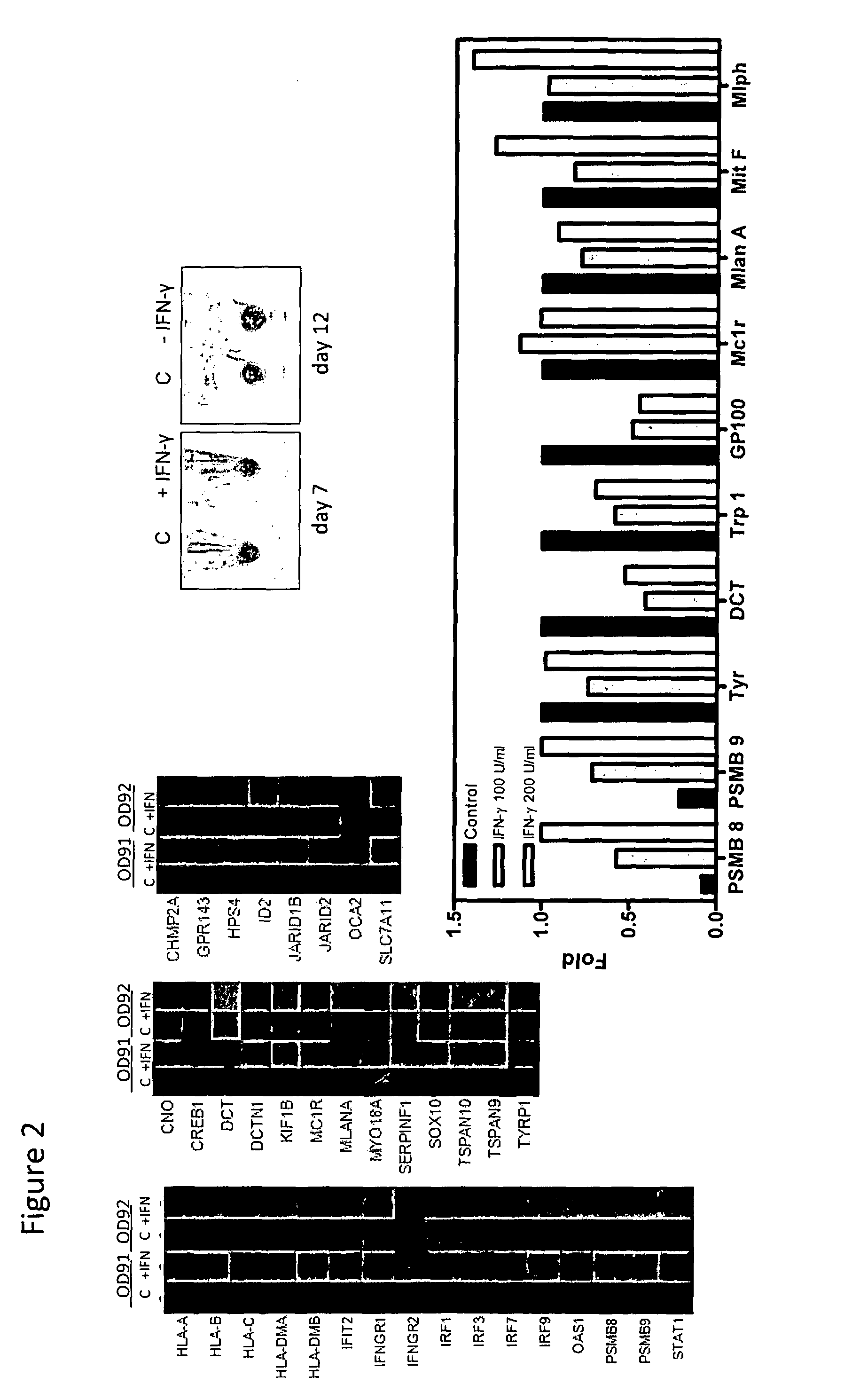Method to modulate pigmentation process in the melanocytes of skin
a pigmentation process and skin technology, applied in the direction of drug compositions, antibacterial agents, peptide/protein ingredients, etc., can solve the problems of significant distress, hypopigmentation in these cells, and marked decrease in the maturation of melanosomes, so as to reduce the level of pigmentation, reduce the level of tyr, and the effect of modulating the visible pigmentation of skin
- Summary
- Abstract
- Description
- Claims
- Application Information
AI Technical Summary
Benefits of technology
Problems solved by technology
Method used
Image
Examples
example 1
[0032]Cultures of normal human epidermal melanocytes (NHEM) (procured from Lonza, or established from epidermis) were maintained in M254 medium containing PMA-free supplements (Invitrogen), at 37° C., in 5% CO2. To study the effect of IFN-γ on melanocytes, early passage cultures of melanocytes were grown in the presence or absence of recombinant human IFN-γ (Peprotech) at a dose of 100U / ml and the cells were observed after 8 days of treatment. Decreased pigmentation could be observed in the cell pellets treated with IFN-γ, confirming the presence of a mechanism for the induction of hypopigmentation (FIG. 1). To understand the molecular targets of human IFN-γ (henceforth referred to simply as IFN-γ) in melanocytes and the mechanism by which the cells are hypopigmented further studies were carried out.
[0033]Melanosome maturation status in the cells and visible pigmentation are tightly linked together. The process of melanin synthesis is sequestered in the late stages of melanosome mat...
example 2
[0034]In order to understand the molecular changes induced by IFN-γ on melanocytes a microarray based study was carried out on two independent primary melanocyte cultures. Cells were treated with 100 U / ml of IFN-γ for 8 days (as mentioned in example 1) and total RNA was isolated and subjected to microarray. Microarray was performed using Illumina whole genome chip Human WG-6. RNA labelling was performed using Illumina total prep RNA labelling kit (Ambion). Subsequent hybridization and washing steps were carried out as per manufacturer's instructions. The data was average normalized; background subtracted and analyzed using Bead-studio software (Illumina). Typical of an immune cytokine IFN-γ elicited a gene expression profile suggestive of an immune response in melanocytes. However the pattern of gene expression also included suppression of certain pigmentation genes (FIG. 2). This confirmed that the hypopigmentory role of IFN-γ is due to the suppression of pigmentation genes by affe...
example 3
[0035]To verify the pathway and elucidate the components of the pathway that mediate the hypopigmenting effect of IFN-γ we resorted to a siRNA based testing of protein functions. Primary human melanocytes were cultured in serum free media as described above (in example 1) and were transfected with 100 nM of siRNA (a mixture of 4 targeting siRNA from Dharmacon) that would target the component mRNA of interest using lipid based transfection reagent (Cellfectin II from Invitrogen). After the transfection the cells were trypsinized and plated in wells and were either treated with IFN-γ or left untreated as control. After 48 h of treatment, cells were lysed and total RNA was prepared from the cells and levels of the targeting gene transcript as well as that of DCT was measured by real-time PCR. Targeting siRNA to JAK-1, STAT-1 and IFNGR-1 substantially decreased the mRNA level of the cognate genes and concomitantly abrogated the IFN-γ mediated suppression of DCT transcript. This series o...
PUM
| Property | Measurement | Unit |
|---|---|---|
| concentrations | aaaaa | aaaaa |
| area | aaaaa | aaaaa |
| transmission electron microscope | aaaaa | aaaaa |
Abstract
Description
Claims
Application Information
 Login to View More
Login to View More - R&D
- Intellectual Property
- Life Sciences
- Materials
- Tech Scout
- Unparalleled Data Quality
- Higher Quality Content
- 60% Fewer Hallucinations
Browse by: Latest US Patents, China's latest patents, Technical Efficacy Thesaurus, Application Domain, Technology Topic, Popular Technical Reports.
© 2025 PatSnap. All rights reserved.Legal|Privacy policy|Modern Slavery Act Transparency Statement|Sitemap|About US| Contact US: help@patsnap.com


